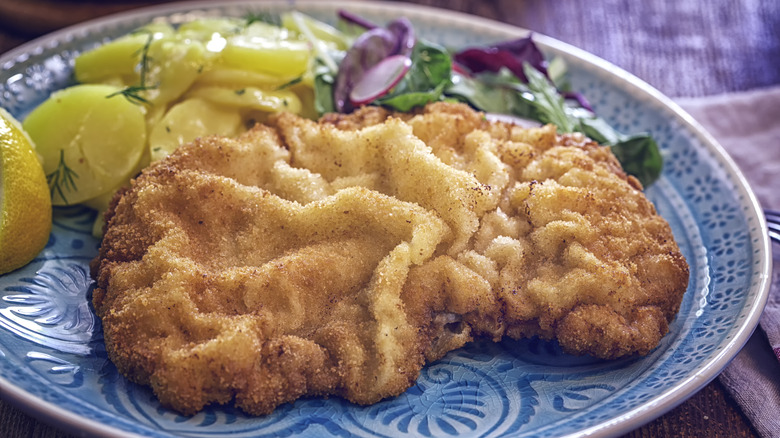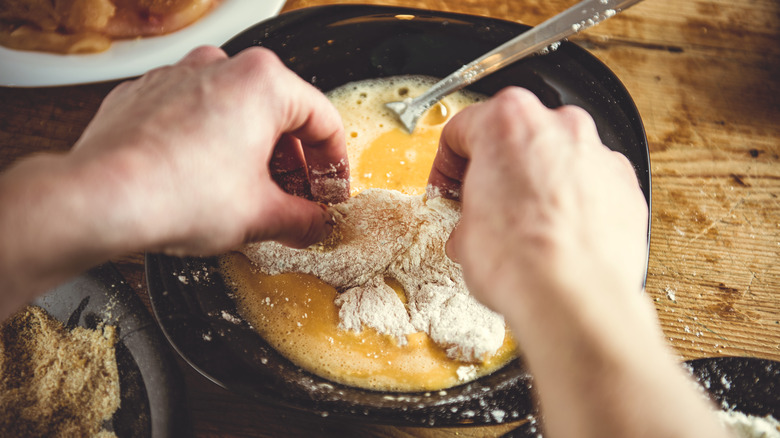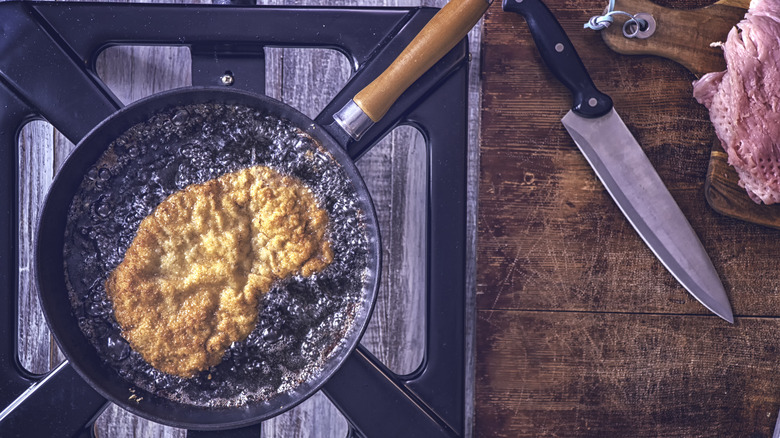The Key To Superior Schnitzel Is All In The Puff
Of all the irresistible types of dishes in the world, those that are breaded and fried may be among the most appealing. From fried mozzarella sticks to Sicilian arancini, and chicken fried steak to Japanese katsu, there is something inherently satisfying about a big crunch hiding a soft, hot, savory interior.
One of the most renowned examples of such a dish is schnitzel, the classic Eastern European dish mostly associated with Austria and Germany. The most basic description of schnitzel is a slice of thinly pounded meat that is breaded and fried until golden brown. But the best, most superior portions of schnitzel are surrounded by puffs of air-filled breading that have separated from the meat.
Normally, breading that detaches from fried foods isn't a good thing. People generally like each bite of their food to cling to crispy chunks of batter or breading, but this is exactly what you don't want when it comes to schnitzel. Achieving such puff doesn't just happen by chance, though. There are some factors that need to be considered and executed in order to get the method just right. For the most part, schnitzel aficionados agree that the size of the breadcrumb matters and that the oil it's fried in needs to be in constant movement.
Small breadcrumbs and oil in motion
Despite its appearance as a giant slab of deep fried meat, schnitzel — whether made from veal, pork, or chicken — is intended to be light and much more delicate than it looks, and part of this is achieving the signature puff. The process of the crust puffing up and away from the meat is known as soufflieren in German. When done successfully, the crust browns beautifully and extremely hot steam is trapped between the breading and the meat. It's this steam that essentially cooks the meat thoroughly, yet gently, which keeps the protein moist.
To achieve this desired state, it's important to create an air-tight seal on the breading, which is why using fine breadcrumbs works really well. When it sticks to the egg wash, minimal pores or openings are created (as opposed to using panko which would let a lot of air through due to its larger size). In addition, perfectly puffy schnitzel is typically created when the oil in which it's cooked is in constant motion, swirling and twirling (very gently) over the top of the meat to promote even cooking. It also helps to create an environment of extreme heat, which creates the steam that pushes the breading away from the meat.
This type of cooking also necessitates thinner cuts of meat, which will cook more rapidly than a thick-cut pork chop, for instance. In the case of the latter, the center could remain raw while the breading becomes golden and the outer portion of the meat gets cooked.
Increase your puff power with vodka
The puff on the cooked schnitzel should remain, even after it's plated and cut into with a knife and fork. You should be able to see the pockets of air surrounding the meat. Schnitzel is typically served with just a squeeze of fresh lemon juice, but it's also not uncommon to see gravies and sauces, like creamy mushroom sauce as in this Jäger Schnitzel recipe, accompanying the cozy dish. If your schnitzel doesn't turn out with much puff, don't worry too much about it. It is still, by all means, a very tasty dish that should check every box in the fried food department.
But some experts suggest some interesting methods to increase your chances of getting some puff in your schnitzel. Some ideas include incorporating a little oil into the egg wash to make the proteins stretch a little more without breaking when fried. Another idea involves brushing the raw, pounded meat with vodka before dredging it in flour and dipping it into the egg wash. When the breaded cutlet is placed into the hot oil, the vodka will rapidly evaporate, creating those coveted steam pockets.



